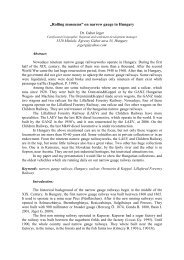'Representing Difficult Pasts within Complex Presents ... - T2M
'Representing Difficult Pasts within Complex Presents ... - T2M
'Representing Difficult Pasts within Complex Presents ... - T2M
You also want an ePaper? Increase the reach of your titles
YUMPU automatically turns print PDFs into web optimized ePapers that Google loves.
accessed, mostly dating from the 1980s, at the Golden Arrow Epping Depot and made available to UWC<br />
researchers 8 . Research discussion suggested the possibilities of a museum exploring a broader concept of<br />
‘mobility’ beyond a conventional ‘transport’ theme. New approaches favoured examining the history of<br />
transport as reflecting not just vehicles themselves, but as reflective and instigative of South African<br />
culture itself. Although, following a year of research, HCI management was uncertain as to whether to go<br />
ahead with the museum project, partly as a consequence of changes in management capability from<br />
<strong>within</strong> HCI Foundation, this paper examines the representational findings, possibilities and implications<br />
for thinking through a museum of transport for Cape Town.<br />
This paper proposes a transport museum concept in Cape Town as an opportunity to challenge<br />
and rework social perceptions, urban divides and legacies, in the present. Through an overview of some<br />
of the displays that are present, and not present, in South African museums selected for the possibility of a<br />
‘mobility’ museum, the paper examines possible exhibition themes, social frameworks through which the<br />
origin and impact of transport history in South Africa may be understood, and the need to challenge,<br />
create debates and engage visitors (both local and further afield) with the understanding and extent to<br />
which the transport past is interconnected and impacts upon the urban present.<br />
Placing these debates at the forefront, it is argued, demands a particularly creative way of<br />
thinking about museum display – open-ended rather than didactic. In particular, the paper rethinks<br />
museums traditionally seen to be technological, or scientific, which are seen to antiquate, make nostalgic<br />
or ‘fetishise’ collected objects as ‘highlights, masterpiece or a collection in its entirety’ (Kirshenblatt-<br />
Gimblett 1991:388) <strong>within</strong> the realm of the socio-political. In a South African context, the paper explores<br />
possibilities for museum exhibitions which, as Divall 9 (2003) suggests, ‘display the history of transport,<br />
travel and mobility through objects in ways that encourage visitors to reflect critically on the past, and<br />
what it means for them’ (263), how to site stories of people and networks as a key theme in relation to<br />
transport exhibitions (Lubar 10 2004), to demonstrate how ‘museum learning is as much about feeling,<br />
emotions and desire – the affective dimension – as it is about formal categorization and analysis’ (Divall<br />
262). 11 The paper argues a complex approach to museum display, to satisfy, as Cameron and Mengler<br />
(2009) put it, ‘a need to explain the meaning of objects beyond disciplinary boundaries ... to rethink<br />
8<br />
Full access to the archives took several months to obtain, due to some initial resistance from<br />
management.<br />
9<br />
Professor Colin Divall of York University attended a workshop at the UWC Transport project in August<br />
18-19 2010<br />
10<br />
Lubar writes of the replacement of a 40 year old transportation exhibition with a new one at the<br />
Smithsonian’s National Museum of American History.<br />
11 Also see Divall and Scott 2001; Divall 2008; 1999; Stratton 1990; Lubar 2004.<br />
4




